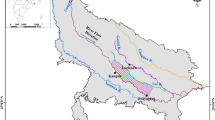Abstract
Okukubi Dam, planned for construction at the midportion of Okinawa Island, is the first concrete gravity dam to be built on the Quaternary limestone and calcareous sand formation in Japan. Principal characteristics of the dam are as given below:
Purpose: flood control, irrigation, potable and industrial water
Dam type: concrete gravity dam
Dam height: 40.9 m
Crest length: 300 m
Volume: 1×105m3
Reservoir capacity: 7×106m3
Active storage capacity: 6.3×106m3
The lower part of the abutment is composed of alternations of Palaeogene standstone and shale. The river bed elevation is nearly equal to the average sea level. The deepest dam base will be placed 12.5 m below sea level after the river deposits and highly weathered rocks are excavated.
The upper part of the abutment, however, is composed of silt, fine sand, calcareous sand and reef limestone. Careful studies have been made to determine the distribution of soluble materials and caverns in the calcareous foundation. In addition, the ground water levels on both banks, composed of Quaternary sediments, were shown to be higher than the maximum water level of the reservoir.
Grouting at both abutments plus a cutoff wall at the right abutment are planned as the foundation treatment. We are still studying the correct way to prevent piping, and are planing to perform grouting tests to obtain the desired watertightness.
Résumé
Barrage d'Okukubi, implanté au millieu de l'île d'Okinawa, est le premier barrage-poids sur la formation de la Quaternaire roche calcaire et du sable calcaire au Japon.
Les caractéristiques principales du barrage sont les suivantes:
Objet: maîtrise des crues, irrigation, eau de la ville et l'industrie
Hauteur du barrage: 40.9 m
Longueur en crête: 300 m
Volume: 1×105 m3
Volume de la retenue: 7×106 m3
Réserve utile: 6.3×106 m3
L'appui dans la partie inférieure est composé du Palaeogene grès et du schiste argileux alternativement. Le niveau du lit mineur est presque même que celui de la moyenne surface de la mer. La base profonde du barrage sera 12.5 m au-dessous de la moyenne surface de la mer après le dépôt fluvial et la roche météoriquement altérée sont fouillés.
L'appui dans la partie supérieure, néanmoins, est composé de silt, de sable fine, de sable calcaire et de grès corallien; les études minuteuses sont faites pour découvrir la distribution des materiaux solubles et des cavernes dans la fondation calcaire. Et les niveaus de la nappe phréatique dans les deux rives, constitués du Quaternaire dépôt solide, sont vérifies d'être plus haut que celui du niveau maximal du reservoir.
L'injection dans les deux appuis et un mur parafouille dans l'appui droit sont envisagés comme traitment des fondations. Maintenant nous étudions pour trouver la méthode appropriée d'empêcher le renard, et faisons un project de l'essai d'injection pour réalizer l'étanchéité désirée.
Similar content being viewed by others
References
KAWANA, T. (1980): Primary Objectives of the Interdisciplinary Discussion on the Problems of the Late Pleistocene-Holocene Periods in the Ryukyu Island. The Quaternary Research, Vol. 18, No. 4, pp. 181–188.
MINOURA, K. (1977): Depositional Sequence of Limestone of the Ryukyu Group. Marine Sciences, Vol. 9, No. 8, pp. 26–32.
Author information
Authors and Affiliations
Rights and permissions
About this article
Cite this article
Okamoto, R., Miura, S. & Takeshita, T. Dam on quaternary limestone and calcareous sand formation. Bulletin of the International Association of Engineering Geology 24, 63–68 (1981). https://doi.org/10.1007/BF02595254
Published:
Issue Date:
DOI: https://doi.org/10.1007/BF02595254




